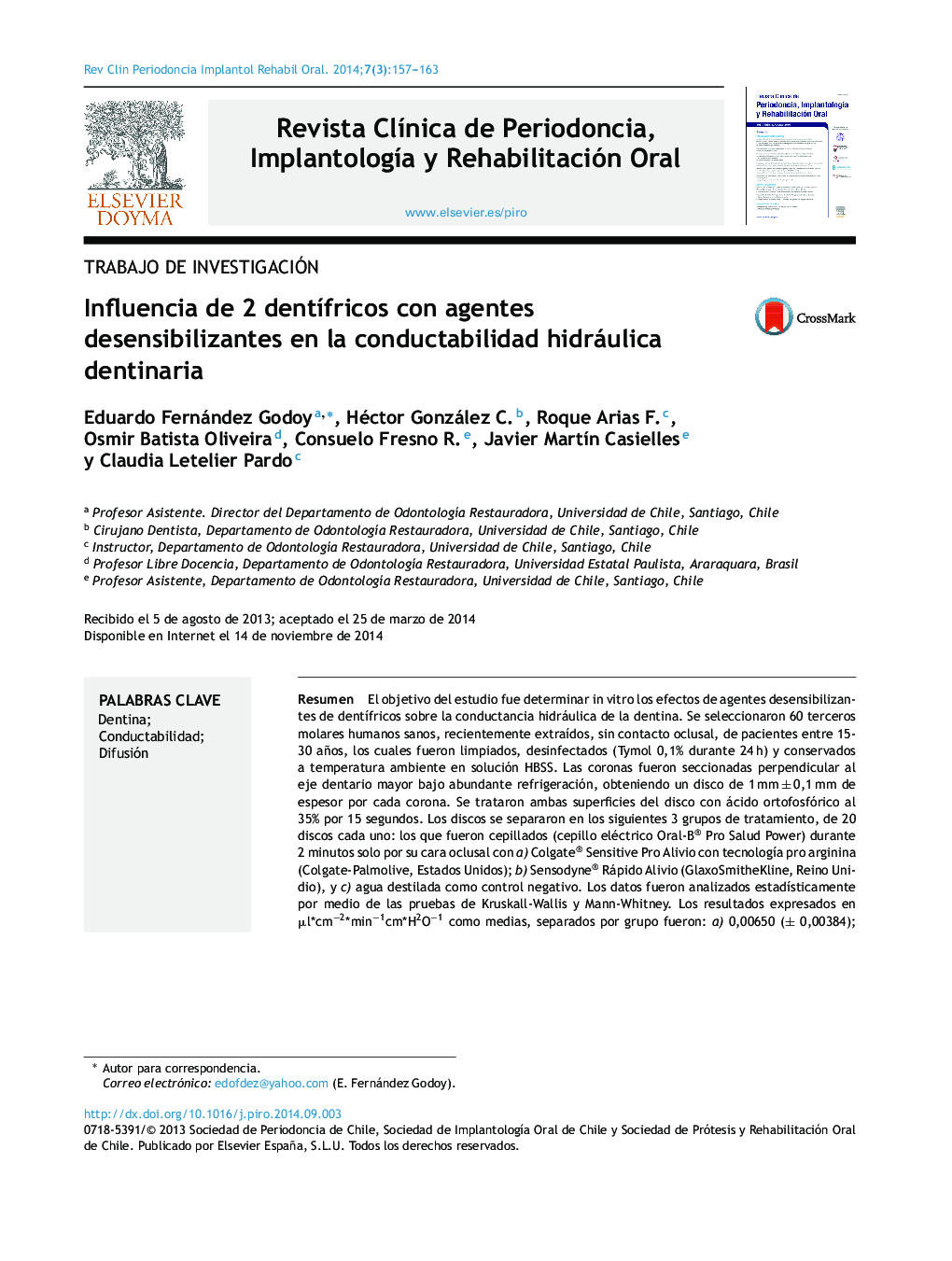| کد مقاله | کد نشریه | سال انتشار | مقاله انگلیسی | نسخه تمام متن |
|---|---|---|---|---|
| 3172367 | 1199936 | 2014 | 7 صفحه PDF | دانلود رایگان |

ResumenEl objetivo del estudio fue determinar in vitro los efectos de agentes desensibilizantes de dentífricos sobre la conductancia hidráulica de la dentina. Se seleccionaron 60 terceros molares humanos sanos, recientemente extraídos, sin contacto oclusal, de pacientes entre 15-30 años, los cuales fueron limpiados, desinfectados (Tymol 0,1% durante 24 h) y conservados a temperatura ambiente en solución HBSS. Las coronas fueron seccionadas perpendicular al eje dentario mayor bajo abundante refrigeración, obteniendo un disco de 1 mm ± 0,1 mm de espesor por cada corona. Se trataron ambas superficies del disco con ácido ortofosfórico al 35% por 15 segundos. Los discos se separaron en los siguientes 3 grupos de tratamiento, de 20 discos cada uno: los que fueron cepillados (cepillo eléctrico Oral-B® Pro Salud Power) durante 2 minutos solo por su cara oclusal con a) Colgate® Sensitive Pro Alivio con tecnología pro arginina (Colgate-Palmolive, Estados Unidos); b) Sensodyne® Rápido Alivio (GlaxoSmitheKline, Reino Unidio), y c) agua destilada como control negativo. Los datos fueron analizados estadísticamente por medio de las pruebas de Kruskall-Wallis y Mann-Whitney. Los resultados expresados en μl*cm−2*min−1cm*H2O−1 como medias, separados por grupo fueron: a) 0,00650 (± 0,00384); b) 0,00800 (± 0,00472), y c) 0,03649 (± 0,03042). Con el estudio se pudo concluir que los 2 agentes desensibilizantes dentinarios presentan significativa disminución de la conductabilidad hidráulica en dentina. Se encontraron diferencias estadísticamente significativas entre el grupo control y Sensodyne® Rápido Alivio (p = 0,000) y entre el grupo control y Colgate® Sensitive Pro Alivio (p = 0,000). No se observó diferencia entre las 2 pastas dentales (p = 0,317).
The aim of the study was to determine the effects of agents toothpastes on the hydraulic conductance of dentin desensitizers “in vitro”. We selected 60 third molars healthy humans, recently extracted without occlusal contact, of patients between 15-30 years, which were cleaned, disinfected (Tymol 0.1% per 24 hours) and preserved at T atmosphere solution for a maximum of 14 days. The crowns were sectioned perpendicular to the tooth axis under abundant refrigeration, obtaining a disc of 1 mm +/-0.1 mm. thickness for each Crown. Disks were separated into the following three groups of treatment, of 20 discs each, which were brushings (brush electrical Oral-B Pro health Power) for 2 minutes only by your face occlusal with; a) Colgate® Sensitive Pro relief with technology Pro arginine (Colgate-Palmolive, USA), b) Sensodyne® quick-relief (GlaxoSmitheKline, UK), and c) distilled water as a negative control. The data were statistically analyzed by Kruskall Wallis and Mann Whitney tests. The results expressed in μl*cm−2*min−1cm*H2O−1as stockings, separated by group were; a) 0,00650 (±0.00384), b) 0,00800 (±0,00472), c) 0 and 03649 (±0,03042). You could be concluded with the study that two dentin desensitizers agents present significant decrease in hydraulic conductance in dentin. Statistically significant differences were found between the group control and Sensodyne® fast relief (p = 0,000) and between group control and Colgate® Sensitive Pro relief (p = 0,000). There was no difference between the two toothpastes (p = 0,317).
Journal: Revista Clínica de Periodoncia, Implantología y Rehabilitación Oral - Volume 7, Issue 3, December 2014, Pages 157–163